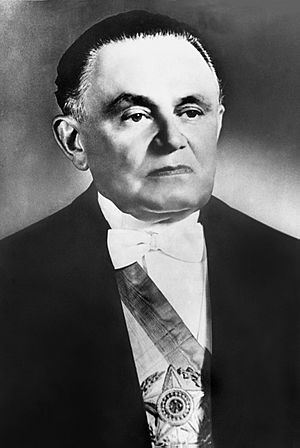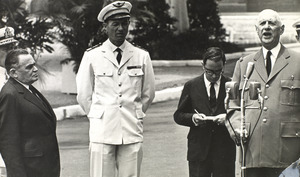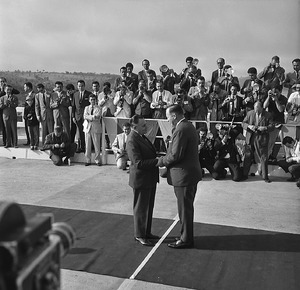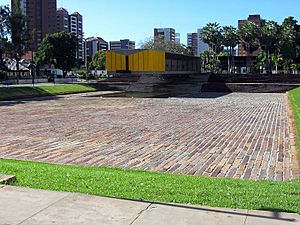Humberto de Alencar Castelo Branco facts for kids
Quick facts for kids
Castelo Branco
|
|
|---|---|

Official portrait, 1964
|
|
| President of Brazil | |
| In office April 15, 1964 – March 14, 1967 |
|
| Vice President | José Maria Alkmin |
| Preceded by | Ranieri Mazzilli (interim) |
| Succeeded by | Artur da Costa e Silva |
| Chief of the Army General Staff | |
| In office September 13, 1963 – April 14, 1964 |
|
| President | João Goulart Ranieri Mazzilli (interim) |
| Preceded by | José Machado Lopes |
| Succeeded by | Décio Palmeiro Escobar |
| Personal details | |
| Born |
Humberto de Alencar Castelo Branco
20 September 1897 Fortaleza, Ceará, Brazil |
| Died | July 18, 1967 (aged 69) Fortaleza, Ceará, Brazil |
| Resting place | Castelo Branco Mausoleum, Fortaleza, Ceará, Brazil |
| Political party | ARENA (1966–1967) |
| Spouse |
Argentina Viana
(m. 1922; died 1963) |
| Children | 2 |
| Parents | Cândido Borges Castelo Branco (father) Antonieta de Alencar Gurgel (mother) |
| Alma mater | Military School of Realengo Officers Improvement School Army General Staff School |
| Signature | |
| Military service | |
| Allegiance | |
| Branch/service | |
| Years of service | 1918–1964 |
| Rank | Field marshal |
| Commands |
|
| Battles/wars |
|
Humberto de Alencar Castelo Branco (born September 20, 1897 – died July 18, 1967) was a Brazilian military leader and politician. He became the first president of the Brazilian military dictatorship after the military took control in 1964. Castelo Branco died in a plane crash in July 1967, shortly after his time as president ended.
Contents
Early Life and Family
Castelo Branco was born into a wealthy family in Northeastern Brazil. His family had roots in Portugal. His father, Cândido Borges Castelo Branco, was a general in the army. His mother, Antonieta Alencar Castelo Branco, came from a family of smart thinkers and writers.
He was married to Argentina Vianna. They had two children, Nieta and Paulo.
Military Career
Castelo Branco joined the Brazilian Army at the Rio Pardo Military School in Rio Grande do Sul. In 1918, he went to the Military School of Realengo in Rio de Janeiro. He became a second lieutenant in 1921. In 1923, he was promoted to first lieutenant.
He became a captain and was known for his intelligence. In 1931, he attended the Command and General Staff College (ECEME). He was the top student in his class. In 1938, he became a major. He then studied at the French War College.
World War II Service
Castelo Branco was promoted to lieutenant colonel in 1943. He also studied at the Command and General Staff College in the United States. He served as the head of operations for the Brazilian Expeditionary Force (FEB) during World War II in Italy. He spent 300 days fighting in battles. He sent many letters to his wife and sons during this time.
In Italy, he planned and carried out military actions, especially at the Battle of Monte Castello. Other military leaders said he was a great strategist. He gained a lot of respect for his skills.
After the War
After the war, Castelo Branco returned to Brazil in 1945. He wanted to share his war experiences with other army officers. He became the Director of Studies at the ECEME. He helped improve how the army trained its leaders.
In 1955, he helped change how the army was managed. He supported a military movement that helped Juscelino Kubitschek become president. Kubitschek's election was being threatened at the time.
Later, Castelo Branco became a general. He commanded the ECEME from 1954 to 1956. He also led military regions in Belém, Fortaleza, and Recife. Before becoming president, he was the Chief of Staff of the Army from 1963 to 1964.
Political Career
Castelo Branco became one of the main leaders of the 1964 Brazilian coup d'état. This event removed President João Goulart from power and ended the Fourth Brazilian Republic. On April 11, the Brazilian Congress chose Castelo Branco to be president. He officially took office on April 15, 1964.
Castelo Branco was the second Brazilian Field Marshal to become president through a military takeover. The first was Deodoro da Fonseca in 1889.

When he became president, Castelo Branco was given special powers. These powers allowed him to make quick changes and remove political rights from people who opposed the government. He initially wanted to allow normal political activities. He also planned to hand over power to a civilian president in 1966.
However, some military officers, known as "hard-liners," wanted to stay in power longer. They had the support of the War Minister, Artur da Costa e Silva. Things became difficult in October 1965 when opposition candidates won elections in important states. The hard-liners wanted Castelo Branco to cancel these election results, but he refused. Another military takeover was avoided when Costa e Silva convinced the hard-liners to accept the results. In return, Castelo Branco promised to adopt tougher policies.

After this, Castelo Branco changed his approach to democracy. On October 27, 1965, he issued the Second Institutional Act. This act got rid of all existing political parties. It also gave him back his special powers and extended his term as president until 1967. The many political parties were replaced by just two: the pro-government National Renewal Alliance Party (ARENA) and the opposition Brazilian Democratic Movement (MDB). In 1967, he created a new, very strict constitution.
Castelo Branco also put in place many strict laws. One important law was a very tough press law. This law remained in effect in Brazil until 2009.
He was followed as president by Artur da Costa e Silva on March 15, 1967.
Castelo Branco's government also got involved in the economy. His government received money and loans from the World Bank and the International Monetary Fund. There was also a lot of investment from large international companies, especially from the United States. These companies saw Brazil's military government as a stable ally against communism during the Cold War.
Death

Four months after leaving the presidency, Castelo Branco died. He was in a small plane that crashed near Fortaleza on July 18, 1967.
Honours
Foreign Honours
 Grand Officer of the Military Order of Aviz (October 12, 1945)
Grand Officer of the Military Order of Aviz (October 12, 1945) Grand Cross of the Legion of Honour (October 14, 1964)
Grand Cross of the Legion of Honour (October 14, 1964) Grand Collar of the Order of Prince Henry (July 21, 1965)
Grand Collar of the Order of Prince Henry (July 21, 1965) Grand Collar of the Order of Merit of the Italian Republic (September 8, 1965)
Grand Collar of the Order of Merit of the Italian Republic (September 8, 1965)
See also
 In Spanish: Humberto de Alencar Castelo Branco para niños
In Spanish: Humberto de Alencar Castelo Branco para niños
- 1964 Brazilian coup d'état
- List of presidents of Brazil
- History of Brazil (1964-present)



